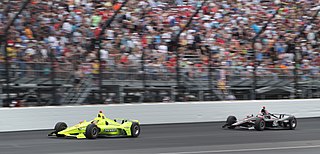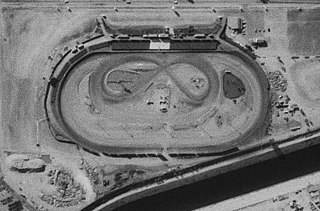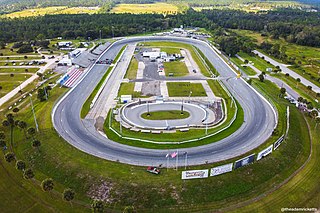Related Research Articles

Auto Club Speedway, originally opened as California Speedway, is a 2.000 mi (3.219 km), low-banked, D-shaped oval superspeedway in unincorporated San Bernardino County, California, near Fontana. It has hosted NASCAR racing annually since 1997. It was also previously used for open wheel racing events. The racetrack is located 47 mi (76 km) east of Los Angeles and is near the former locations of Ontario Motor Speedway and Riverside International Raceway. The track is owned and operated by NASCAR. The speedway is served by the nearby Interstate 10 and Interstate 15 freeways as well as a Metrolink station located behind the backstretch.

Oval track racing is a form of closed-circuit motorsport that is contested on an oval-shaped race track. An oval track differs from a road course in that the layout resembles an oval with turns in only one direction, and the direction of traffic is almost universally counter-clockwise. Oval tracks are dedicated motorsport circuits, used predominantly in the United States. They often have banked turns and some, despite the name, are not precisely oval, and the shape of the track can vary.

Raffaele "Ralph" De Palma was an Italian-American racecar driving champion who won the 1915 Indianapolis 500. His entry at the International Motorsports Hall of Fame estimates that he won about 2,000 races. DePalma won the 1908, 1909, 1910, and 1911 American AAA national dirt track championships and is credited with winning 24 American Champ car races. He won the Canadian national championship in 1929. DePalma estimated that he had earned $1.5 million by 1934 after racing for 27 years. He is inducted in numerous halls of fame. He competed on boards and dirt road courses and ovals.
Kelly Carl Petillo was an American racecar driver born in Pittsburgh.
Travis Webb was an American racecar driver from Joplin, Missouri. He was the 1948 American Automobile Association (AAA) Midwest Sprint Car champion. He raced in numerous AAA Champ Car races including six Indianapolis 500.

American open-wheel car racing, also known as Indy car racing, is a category of professional automobile racing in the United States. As of 2022, the top-level American open-wheel racing championship is sanctioned by IndyCar.

Ascot Park, first named Los Angeles Speedway, and later New Ascot Stadium, was a dirt racetrack located near Gardena, California. Ascot Park was open between 1957 and 1990. The track held numerous United States Auto Club (USAC) national tour races and three NASCAR Grand National (now NASCAR Cup Series races. The Turkey Night Grand Prix was held at the track for several decades.

Ralph R. Hepburn was a pioneer American motorcycle racing champion and an Indianapolis 500 racecar driver.

Fredrick William Frame was an American race car driver. One of the leading AAA Championship Car drivers of the late 1920s and early 1930s, Frame is best remembered for his victory at the 1932 Indianapolis 500.

Board track racing was a type of motorsport popular in the United States during the 1910s and 1920s. Competition was conducted on circular or oval race courses with surfaces composed of wooden planks. This type of track was first used for motorcycle competition, wherein they were called motordromes, before being adapted for use by various different types of racing cars. The majority of the American national championship races were contested at such venues during the 1920s.

New Smyrna Speedway is a 1/2-mile asphalt oval racetrack located near New Smyrna Beach, Florida, that races the NASCAR Advance Auto Parts Weekly Series every Saturday night. It also has a smaller track, known as "Little New Smyrna Speedway" in the infield. This track races quarter midgets on Friday nights.
Edgar Alan Gordon was an American racecar driver.
Frank Wearne was an American racecar driver. He grew up in Altadena, California and began his racing career in roadsters on the Jeffries Ranch track in Burbank. He moved on to race at the Culver City Legion Speedway dirt track and Legion Ascot Speedway. After Ascot closed, Wearne raced successfully in the Pacific Northwest, then headed to the Midwest. An Indianapolis 500 specialist, he participated in the race 7 times, with a best finish of 7th in 1940. He only made two Championship Car starts in races other than the Indy 500. After retiring from racing, he worked at a brewery for 20 years
Robert Elwood Carey was an American racecar driver.
The Automotive Racing Products Turkey Night Grand Prix is an annual race of midget cars. It is the third oldest race in the United States behind the Indianapolis 500 and the Pikes Peak International Hill Climb. It has been held on Thanksgiving night most years since 1934, where it was founded by Earl Gilmore at his Gilmore Stadium in Los Angeles. It stayed at this location until 1950. Since that time it has been held at various southern California race tracks. Since 1955, the race has been promoted by J. C. Agajanian and later his descendants, currently by son Cary. Traditionally a dirt track event, it has sometimes been on asphalt during the turn of the 21st century, although it returned to dirt in 2012. The feature race was held over 98 laps in the modern era, the same number that Agajanian used for his racecars.
Danny Oakes was an American midget car hall of fame driver.

Orange County Fair Speedway is a 0.625 mi (1.006 km) dirt oval speedway in Middletown, Orange County, New York. The facility holds weekly stock car races and demolition derbies during the summer months. The track was built in 1857 for horse racing at the Orange County Fair and staged its first automobile race on August 16, 1919. The fair began as an agricultural exhibit in 1843 and was permanently located in the Wallkill–Middletown area in 1857. The speedway is located at 239 Wisner Avenue in Middletown on land which was known as The Ogden Tract in the mid-1850s. It was originally a half-mile horse racing track known as the Harry Clay Oval, named after a race horse that was famous at that time. Over the years, the track was widened and lengthened to a true 5/8-mile race track.
Cajon Speedway is a former oval race track near El Cajon, California.
George Roy Bentel was an American automobile dealer and the first owner of the Legion Ascot Speedway. Bentel was inducted into the National Sprint Car Hall of Fame in 2010 for his contributions to the sport.

The 2022 WISE Power 400 was the second stock car race of the 2022 NASCAR Cup Series and the 25th running of the event. The race was held on Sunday, in Fontana, California, at Auto Club Speedway, a 2 miles (3.2 km) permanent D-shaped oval racetrack. The race took the scheduled 200 laps to complete. At race's end, Kyle Larson, driving for Hendrick Motorsports, would win a drama-filled race after a controversial block on teammate Chase Elliott within the closing laps of the race had put Elliott in the wall. Larson would defend the field on the final restart to win his 17th career NASCAR Cup Series win and his first of the season. To fill out the top 3, Austin Dillon of Richard Childress Racing and Erik Jones of Petty GMS Motorsports would finish second and third, respectively.
References
- ↑ Theobald, Mark. "George Bentel". National Sprint Car Hall of Fame & Museum . Archived from the original on April 28, 2021.
- ↑ Theobald, Mark (2004). "George R. Bentel Co". Coachbuilt. Archived from the original on November 5, 2019.
- 1 2 3 4 5 6 7 8 9 10 11 Rasmussen, Cecilia (October 10, 1994). "Life – and death – in fast lane at Ascot". Los Angeles Times . Archived from the original on April 30, 2021.
- ↑ "Legion Ascot Speedway". ChampCarStats.com. Archived from the original on January 31, 2022.
- ↑ "Motor racing events on dirt track to be staged weekly in Los Angeles". The Los Angeles Times. December 6, 1923. Archived from the original on February 1, 2022.
- ↑ Frayne, Ed. (January 21, 1924). "Dirt racing proves huge success at Ascot". Los Angeles Record . Archived from the original on February 1, 2022.
- ↑ "Press agent did his bit". The Pomona Progress . United Press. January 22, 1924. Archived from the original on February 1, 2022.
- 1 2 "Jimmy Craft is killed in Ascot Speedway crash". The Los Angeles Times. February 4, 1924. Archived from the original on January 31, 2022.
- 1 2 3 4 "Speedway suit filed in court". The Los Angeles Times. November 10, 1925. Archived from the original on February 1, 2022.
- ↑ "Drivers protest Frank Lockart's victory in Ascot road race". The Los Angeles Times. November 29, 1924. Archived from the original on January 31, 2022.
- ↑ "Bentel faces felony charge". The Los Angeles Times. December 11, 1924. Archived from the original on February 1, 2022.
- ↑ "Speedway officials get suspended terms". San Francisco Examiner . April 28, 1925. Archived from the original on January 31, 2022.
- ↑ "Ascot Speedway reopens Sunday with fast bill". Illustrated Daily News . Los Angeles, California. January 20, 1925. Archived from the original on January 31, 2022.
- ↑ Ziff, Sid (December 20, 1929). "The inside track". Evening Express . Los Angeles, California. Archived from the original on January 31, 2022.
- ↑ Ziff, Sid (December 23, 1929). "The inside track". Evening Express. Los Angeles, California. Archived from the original on February 1, 2022.
- ↑ "Legionnaires to take over Ascot track". Los Angeles Times. March 3, 1929. Archived from the original on January 31, 2022.
- ↑ "Speedway's name is changed officially". Los Angeles Times. June 6, 1930. Archived from the original on January 31, 2022.
- 1 2 3 "El Sereno's Legion Ascot Speedway". El Sereno Historical Society. Archived from the original on February 1, 2022.
- ↑ "The "Killer Track" once attracted fans of cars and speed to El Sereno". The Eastsider. January 14, 2015. Archived from the original on November 5, 2019.
- 1 2 Price, Paul (July 11, 1934). "Speed merchants set as Ascot track reopens tonight". Hollywood Citizen-News . Archived from the original on February 1, 2022.
- 1 2 3 "Ascot". The GEL Motorsport Information Page. Archived from the original on January 14, 2020.
- 1 2 "Old track, made safer, re-opened at Legion Ascot". Covina Citizen . November 23, 1934. Archived from the original on January 31, 2022.
- ↑ Coughlin, Gene (September 5, 1935). "Legion drops auto racing at Ascot". Los Angeles Evening Post-Record . Archived from the original on January 31, 2022.
- ↑ "Auto racing bows out at Ascot". Los Angeles Evening Post-Record. September 26, 1935. Archived from the original on January 31, 2022.
- ↑ "Bill White to reopen Ascot saucer Sunday". Los Angeles Times. October 13, 1935. Archived from the original on January 31, 2022.
- ↑ "Gordon, mechanic die in crash". Oakland Tribune . Associated Press. January 27, 1936. Archived from the original on February 1, 2022.
- ↑ Hertel, Howard (April 14, 1936). "City council okays new auto track". Illustrated Daily News. Los Angeles, California. Archived from the original on January 31, 2022.
- ↑ "Fire damages Ascot track". The San Bernardino Daily Sun . Associated Press. April 27, 1936. Archived from the original on February 1, 2022.
- ↑ "Ascot Motor Speedway #2, Lincoln Heights, Los Angeles, CA". PCAD . Archived from the original on November 5, 2019.
- ↑ Newman, Claude (April 29, 1936). "For what it's worth". Hollywood Citizen-News. Archived from the original on January 31, 2022.
- ↑ "South Gate auto racing oval opens tomorrow". Illustrated Daily News. Los Angeles, California. June 6, 1936. Archived from the original on January 31, 2022.
- ↑ "Southgate track to change name to Ascot today". Los Angeles Times. January 23, 1938. Archived from the original on January 31, 2022.
- ↑ Glick, Shav (November 17, 1990). "End of an era". Los Angeles Times. Archived from the original on November 23, 2021.